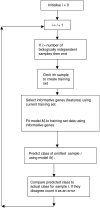Diagnostic and prognostic prediction using gene expression profiles in high-dimensional microarray data
- PMID: 14583755
- PMCID: PMC2394420
- DOI: 10.1038/sj.bjc.6601326
Diagnostic and prognostic prediction using gene expression profiles in high-dimensional microarray data
Abstract
DNA microarrays are a potentially powerful technology for improving diagnostic classification, treatment selection and therapeutics development. There are, however, many potential pitfalls in the use of microarrays that result in false leads and erroneous conclusions. This paper provides a review of the key features to be observed in developing diagnostic and prognostic classification systems based on gene expression profiling and some of the pitfalls to be aware of in reading reports of microarray-based studies.
Figures


Similar articles
-
Using DNA microarrays for diagnostic and prognostic prediction.Expert Rev Mol Diagn. 2003 Sep;3(5):587-95. doi: 10.1586/14737159.3.5.587. Expert Rev Mol Diagn. 2003. PMID: 14510179 Review.
-
Applications of array technology: melanoma research and diagnosis.Expert Rev Mol Diagn. 2004 Jul;4(4):549-57. doi: 10.1586/14737159.4.4.549. Expert Rev Mol Diagn. 2004. PMID: 15225102 Review.
-
Microarrays for cancer diagnosis and classification.Adv Exp Med Biol. 2007;593:74-85. doi: 10.1007/978-0-387-39978-2_8. Adv Exp Med Biol. 2007. PMID: 17265718 Review.
-
Converting a breast cancer microarray signature into a high-throughput diagnostic test.BMC Genomics. 2006 Oct 30;7:278. doi: 10.1186/1471-2164-7-278. BMC Genomics. 2006. PMID: 17074082 Free PMC article.
-
[Microarray data analysis].Ugeskr Laeger. 2006 May 29;168(22):2159-62. Ugeskr Laeger. 2006. PMID: 16768955 Danish.
Cited by
-
Microarrays and breast cancer clinical studies: forgetting what we have not yet learnt.Breast Cancer Res. 2005;7(3):96-9. doi: 10.1186/bcr1017. Epub 2005 Apr 1. Breast Cancer Res. 2005. PMID: 15987437 Free PMC article. Review.
-
Weighted set enrichment of gene expression data.BMC Syst Biol. 2013;7 Suppl 4(Suppl 4):S10. doi: 10.1186/1752-0509-7-S4-S10. Epub 2013 Oct 23. BMC Syst Biol. 2013. PMID: 24565001 Free PMC article.
-
Identification of a small optimal subset of CpG sites as bio-markers from high-throughput DNA methylation profiles.BMC Bioinformatics. 2008 Oct 27;9:457. doi: 10.1186/1471-2105-9-457. BMC Bioinformatics. 2008. PMID: 18954440 Free PMC article.
-
Competence Classification of Cumulus and Granulosa Cell Transcriptome in Embryos Matched by Morphology and Female Age.PLoS One. 2016 Apr 29;11(4):e0153562. doi: 10.1371/journal.pone.0153562. eCollection 2016. PLoS One. 2016. PMID: 27128483 Free PMC article.
-
Microarray applications in cancer research.Cancer Res Treat. 2004 Aug;36(4):207-13. doi: 10.4143/crt.2004.36.4.207. Epub 2004 Aug 31. Cancer Res Treat. 2004. PMID: 20368836 Free PMC article.
References
-
- Alizadeh AA, Eisen MB, Davis RE, Ma C, Lossos IS, Rosenwald A, Boldrich JC, Sabet H, Tran T, Yu X, Powell JI, Yang L, Marti GE, Moore T, Hudson J, Lu L, Lewis DB, Tibshirani R, Sherlock G, Chan WC, Greiner TC, Weisenburger DD, Armitage JO, Warnke R, Levy R, Wilson W, Grever MR, Byrd JC, Botstein D, Brown PO, Staudt LM (2000) Distinct types of diffuse large B-cell lymphoma identified by gene expression profiling. Nature 403: 503–511 - PubMed
-
- Ben-Dor A, Bruhn L, Friedman N, Nachman I, Schummer M, Yakhini Z (2000) Tissue classification with gene expression profiles. J Comput Biol 7: 559–584 - PubMed
-
- Bittner M, Meltzer P, Chen Y, Jiang Y, Seftor E, Hendrix M, Radmacher M, Simon R, Yakhini Z, Ben-Dor A, Dougherty E, Wang E, Marincola F, Gooden C, Lueders J, Glatfelter A, Pollock P, Gillanders E, Leja D, Dietrich K, Beaudry C, Berens M, Alberts D, VSondak Hayward N, Trent J (2000) Molecular classification of cutaneous malignant melanoma by gene expression profiling. Nature 406: 536–540 - PubMed
Publication types
MeSH terms
LinkOut - more resources
Full Text Sources
Other Literature Sources

